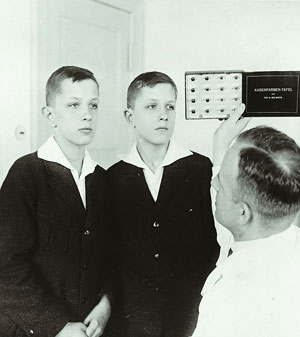Science as Salvation

- Otmar von Verschuer in his laboratory for twin research at the Kaiser-Wilhelm-Institut for Anthropology, Human Genetics and Eugenics in Berlin, 1928
© Archiv zur Geschichte der Max-Planck-Gesellschaft, Berlin
Section one of the exhibition discusses the growing support for proposals known as racial hygiene within German government, medical, and scientific circles after World War I. This history is presented within the context of the international eugenics movement.
By keeping the "unfit" alive to reproduce and multiply, eugenics proponents everywhere argued, modern medicine and costly welfare programs interfered with "natural selection," the concept Darwin applied to the animal and plant world. In addition, members of the "fit," educated classes were having smaller families. In Germany, experts serving on government committees and conducting research on human genetics, warned that if the nation did not produce more healthy children, it was headed for extinction. A growing faction viewed "Nordics" as "eugenically advantageous" and "race mixing" as potentially harmful.
Postwar careers
Only a few of the doctors and scientists who participated in the crimes were ever put on trial or convicted. After the end of the war, a number fled to other countries, but most were able to continue their careers as doctors and scientists in the Federal Republic of Germany.

